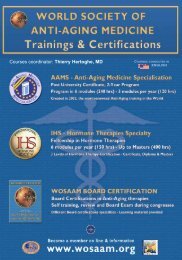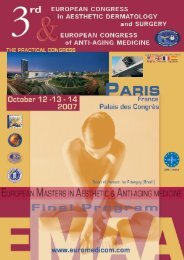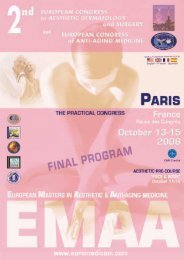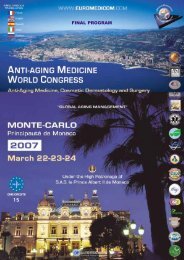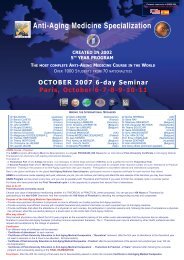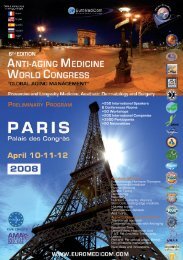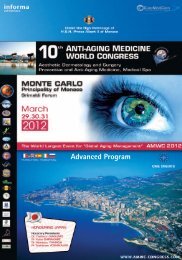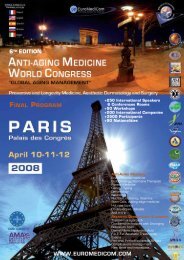FINAL PROGRAM 6TH EDITION - EuroMediCom
FINAL PROGRAM 6TH EDITION - EuroMediCom
FINAL PROGRAM 6TH EDITION - EuroMediCom
Create successful ePaper yourself
Turn your PDF publications into a flip-book with our unique Google optimized e-Paper software.
combination of coordination or ionic bonds.Virtually all biochemicals exhibit the ability to dissolve metal cations. Thus proteins, polysaccharides, and polynucleic acids areexcellent polydentate ligands for many of the metal ions.Chelation therapy describes the use of chelating agents to detoxify poisonous metal agents such as mercury, arsenic, and lead byconverting them to a chemically inert form that can be excreted without further interaction with the body. Very often, there is confusionbetween detoxification and chelation. Detoxification should be used to describe techniques used to help the body eliminate a toxic.Testing of homocystein, antioxidant (selenium, vitamine C and B, SOD, glutathion peroxydase), and magnesium is absolutelynecessary before practicing any chelation.The use of chelation in case of acute metal intoxication or high chronic metal intoxication is medically well understood and accepted.In case of slight environmental intoxication the problem is different; the presence of mercury in the hair of in the urine is not the proofof a metal intoxication. As many chelating treatments have proven or potential side effects, especially because there are not specificof a metal, it is important to prove the intoxication. The Melisa test ® is actually the best biological test for metal intoxication.It is also important to follow the metal intoxication through a Melisa ® test or urine dosage before and after chelation. If the metal intakeis stopped the intoxication will disappear spontaneously in a few months. If it is not possible to stop the metal intake the chelationshould theoretically be continued over a long period but the innocuousness of such a treatment has not be proven.Oral chelation is only efficient on the intestine content.The chelator ties to metals present in the intestine. As it is not a specific reaction it can tie to any metals from magnesium or calciumto mercury. If the heavy metal is regularly absorbed as it is the case for teeth fillings or if the food is polluted with toxic metals this kindof chelation could be prescribed. This kind of chelation may also interfere with the reabsorption of toxic metals eliminated through theliver into the bile.Oral DMSA speeds the elimination of mercury, lead, and arsenic, antimony, bismuth, and gold it is considered as the safest and mostscientifically studied.Chlorella is a genus of single-celled green algae. In vitro Chlorella is capable of absorbing a great quantity of metals. It has proven itsefficiency when absorbed with the metal in mice. The few data we have from case reports demonstrate that the increase of metalexcretion is only in feces and not in urine. This should stop all the literature about the action of chlorella in side the vessels or theneurological system. There are no serious medical studies proving efficacy in case of intoxication in human beings. This is verysurprising because the claims for mobilization of mercury from tissues or facilitation of mercury excretion are not scientifically proven.Cilantro, a particular form of coriander, is in the same scientific situation as chlorella.D-penicillamine is used in Wilson's disease to chelate copper.Other molecules like glutathione and lipoic acid have shown a slight in vitro chelation capacity. Their efficacy is probably more tied toa positive reinforcement of the body's detoxification capacity than a chelating effect. Many so called "chelating food complements" arein this situationIV chelation is usually practiced with EDTAEDTA is the abbreviation for ethylenediaminetetraacetic acid. This amino acid is widely used to sequester di- and trivalent metal ions.EDTA binds to metals via four carboxylate and two amine groups. EDTA forms especially strong complexes with Mn, Pb Cu, Fe, andCo. It also ties to Calcium, magnesium and many heavy metals. It has very few effects on mercury intoxication. Doctor Wittel anAmerican MD practicing a lot of EDTA chelation in the USA estimates that approximately 500 000 American take this treatment everyyear. The main use seems to be for arteriosclerosis with the aim to take away the calcium from the arteries. It is also used in manyother indication such metabolic disturbances (cholesterol excess, diabetes), bone and muscle pain, antiaging (skin, Alzheimer, hair,eyes) and chronic fatigue syndrome. The positive impact on cardiovascular disease has not been scientifically proven in any doubleblind test but a very big trials is being conducted at the moment to prove or infirm the benefit for post cardiac infarctus patient(http://nccam.nih.gov/chelation). The positive impact on lead intoxication is not to be discussed. But we are lacking studies on humansfor other heavy metals intoxication. It is always associated with minerals and vitamins supplementation because of its chelating effects.ANTI-AGING MEDICINEDMPS is potentially too toxic to use and no longer has place in the practice of medicine. Some continue to use it for acute mercuryintoxication, but it may not be safe.Déféroxamine is used for iron or aluminium acute intoxicationConclusion: Chelation seems to be therapeutically interesting. A number of case reports are in favor of this kind of treatment. We needmore scientific experimentation on humans to validate the technique and have a better estimation of the risks. It should never beisolated from estimation and treatment of the body capacity of desintoxication.Chelators as antidotes of metal toxicity: therapeutic and experimental aspects. Blanusa M, Varnai VM, Piasek M, Kostial K. Curr MedChem. 2005;12(23):2771-94.Cilantro, Chlorella and Heavy metals. John Millet Medical Herbalism Vol 14 n°4:17-20Treatment of Mercury and Lead Poisonings with Dimercaptosuccinic Acid (DMSA) and Sodium Dimercaptopropanesulfonate (DMPS)Jan Aaseth, Dag Jacobsen, Ole Andersen, Elsa WickstrØm Analyst 1995 Mar; Vol 120, page 853ff91




